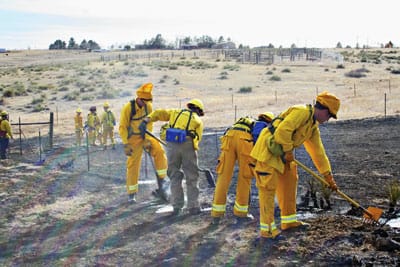Strategies to keep your home safe from wildfire

South Metro Fire Rescue Authority firefighters put out hot spots after containing a brush fire in Parker earlier this year.
Information submitted by South Metro Fire Rescue
Little moisture in Douglas County this winter and spring have created extremely dry conditions which could worsen. The South Metro Fire Rescue offers the following information to help protect your home from fires.
Wildfire is part of our ecosystem: wildfires created the landscape we love in Douglas County. Since the beginning of the year, South Metro Fire Rescue Authority (SMFR) has responded to 13 brush fires, and with the dry winter and warmer temperatures approaching more are expected. While we can’t change the weather or the topography, we can make our properties and structures less vulnerable to damage from fire.
Most structures do not ignite from direct flame contact. Wildfires tend to ignite structures via radiant heat. As a fire is burning, the heat passes through air to objects that warm to the point of ignition then smolder for hours. Radiant heat also passes through windows and may ignite materials inside a home, bypassing the exterior walls altogether.
As a homeowner, your role includes making the house resistant to radiant heat: use a non-combustible roofing material, non-combustible siding, and prevent woody debris from accumulating under decks and in gutters. Also, move furniture away from windows if a fire approaches and remove lacey curtains from windows, use heavier fabrics or shingles to protect windows and keep the radiant heat out.
Radiant heat also causes grasses to warm and trees to dry, making them more susceptible to ignition. Low-lying branches, called ladder fuels, enable grass fires to climb into the tops of trees. Fires burning in the crowns of trees are difficult to fight. One significant goal of creating defensible space is to drop fires from aerial fuels onto the ground where firefighters can deal with them. Remove ladder fuels by thinning trees so that the branches do not touch each other. Also trim grasses around trees and around the structure.
Embers are another ignition source for structure fires. As fires burn, they suck in oxygen and push heated air upward. That column of rising air contains embers and tosses them anywhere, including onto unburned fuels. These “spot fires” are tough to manage.
SMFR’s public educator Einar Jensen is available to provide risk reduction presentations to homeowner associations and groups, as well as home ignition zone assessments for individual property owners. He can be reached at 720-989-2273 or by e-mail.